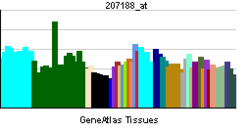- Cyclin-dependent kinase 3
-
Cyclin-dependent kinase 3 Identifiers Symbols CDK3; External IDs OMIM: 123828 HomoloGene: 74387 GeneCards: CDK3 Gene EC number 2.7.11.22 Gene Ontology Molecular function • nucleotide binding
• cyclin-dependent protein kinase activity
• ATP bindingBiological process • cell cycle
• mitosis
• cell proliferation
• cell divisionSources: Amigo / QuickGO RNA expression pattern 

More reference expression data Orthologs Species Human Mouse Entrez 1018 n/a Ensembl ENSG00000250506 n/a UniProt Q00526 n/a RefSeq (mRNA) NM_001258 n/a RefSeq (protein) NP_001249 n/a Location (UCSC) Chr 17:
74 – 74 Mbn/a PubMed search [1] n/a Cell division protein kinase 3 is an enzyme that in humans is encoded by the CDK3 gene.[1][2]
CDK3 complements cdc28 mutants of Saccharomyces cerevisiae suggesting that it may be involved in cell cycle control. CDK3 can phosphorylate histone H1 and interacts with an unknown type of cyclin.[2]
References
- ^ Meyerson M, Enders GH, Wu CL, Su LK, Gorka C, Nelson C, Harlow E, Tsai LH (Aug 1992). "A family of human cdc2-related protein kinases". EMBO J 11 (8): 2909–17. PMC 556772. PMID 1639063. http://www.pubmedcentral.nih.gov/articlerender.fcgi?tool=pmcentrez&artid=556772.
- ^ a b "Entrez Gene: CDK3 cyclin-dependent kinase 3". http://www.ncbi.nlm.nih.gov/sites/entrez?Db=gene&Cmd=ShowDetailView&TermToSearch=1018.
Further reading
- Bullrich F, MacLachlan TK, Sang N, et al. (1995). "Chromosomal mapping of members of the cdc2 family of protein kinases, cdk3, cdk6, PISSLRE, and PITALRE, and a cdk inhibitor, p27Kip1, to regions involved in human cancer.". Cancer Res. 55 (6): 1199–205. PMID 7882308.
- Gyuris J, Golemis E, Chertkov H, Brent R (1993). "Cdi1, a human G1 and S phase protein phosphatase that associates with Cdk2.". Cell 75 (4): 791–803. doi:10.1016/0092-8674(93)90498-F. PMID 8242750.
- Sasaguri T, Ishida A, Kosaka C, et al. (1996). "Phorbol ester inhibits the phosphorylation of the retinoblastoma protein without suppressing cyclin D-associated kinase in vascular smooth muscle cells.". J. Biol. Chem. 271 (14): 8345–51. doi:10.1074/jbc.271.14.8345. PMID 8626531.
- Meikrantz W, Schlegel R (1996). "Suppression of apoptosis by dominant negative mutants of cyclin-dependent protein kinases.". J. Biol. Chem. 271 (17): 10205–9. doi:10.1074/jbc.271.17.10205. PMID 8626584.
- Hofmann F, Livingston DM (1996). "Differential effects of cdk2 and cdk3 on the control of pRb and E2F function during G1 exit.". Genes Dev. 10 (7): 851–61. doi:10.1101/gad.10.7.851. PMID 8846921.
- Lamphere L, Fiore F, Xu X, et al. (1997). "Interaction between Cdc37 and Cdk4 in human cells.". Oncogene 14 (16): 1999–2004. doi:10.1038/sj.onc.1201036. PMID 9150368.
- Braun K, Hölzl G, Soucek T, et al. (1998). "Investigation of the cell cycle regulation of cdk3-associated kinase activity and the role of cdk3 in proliferation and transformation.". Oncogene 17 (17): 2259–69. doi:10.1038/sj.onc.1202145. PMID 9811456.
- Yamochi T, Semba K, Tsuji K, et al. (2002). "ik3-1/Cables is a substrate for cyclin-dependent kinase 3 (cdk 3).". Eur. J. Biochem. 268 (23): 6076–82. doi:10.1046/j.0014-2956.2001.02555.x. PMID 11733001.
- Sato H, Nishimoto I, Matsuoka M (2002). "ik3-2, a relative to ik3-1/cables, is associated with cdk3, cdk5, and c-abl.". Biochim. Biophys. Acta 1574 (2): 157–63. PMID 11955625.
- Schang LM, Bantly A, Schaffer PA (2002). "Explant-induced reactivation of herpes simplex virus occurs in neurons expressing nuclear cdk2 and cdk4.". J. Virol. 76 (15): 7724–35. doi:10.1128/JVI.76.15.7724-7735.2002. PMC 136347. PMID 12097586. http://www.pubmedcentral.nih.gov/articlerender.fcgi?tool=pmcentrez&artid=136347.
- Ota T, Suzuki Y, Nishikawa T, et al. (2004). "Complete sequencing and characterization of 21,243 full-length human cDNAs.". Nat. Genet. 36 (1): 40–5. doi:10.1038/ng1285. PMID 14702039.
- Ren S, Rollins BJ (2004). "Cyclin C/cdk3 promotes Rb-dependent G0 exit.". Cell 117 (2): 239–51. doi:10.1016/S0092-8674(04)00300-9. PMID 15084261.
- Zhang Y, Wolf-Yadlin A, Ross PL, et al. (2005). "Time-resolved mass spectrometry of tyrosine phosphorylation sites in the epidermal growth factor receptor signaling network reveals dynamic modules.". Mol. Cell Proteomics 4 (9): 1240–50. doi:10.1074/mcp.M500089-MCP200. PMID 15951569.
- Beausoleil SA, Villén J, Gerber SA, et al. (2006). "A probability-based approach for high-throughput protein phosphorylation analysis and site localization.". Nat. Biotechnol. 24 (10): 1285–92. doi:10.1038/nbt1240. PMID 16964243.
- Olsen JV, Blagoev B, Gnad F, et al. (2006). "Global, in vivo, and site-specific phosphorylation dynamics in signaling networks.". Cell 127 (3): 635–48. doi:10.1016/j.cell.2006.09.026. PMID 17081983.
- Wissing J, Jänsch L, Nimtz M, et al. (2007). "Proteomics analysis of protein kinases by target class-selective prefractionation and tandem mass spectrometry.". Mol. Cell Proteomics 6 (3): 537–47. doi:10.1074/mcp.T600062-MCP200. PMID 17192257.
External links
B bsyn: dna (repl, cycl, reco, repr) · tscr (fact, tcrg, nucl, rnat, rept, ptts) · tltn (risu, pttl, nexn) · dnab, rnab/runp · stru (domn, 1°, 2°, 3°, 4°) Categories:- Human proteins
- Enzyme stubs
- Cell cycle
Wikimedia Foundation. 2010.
